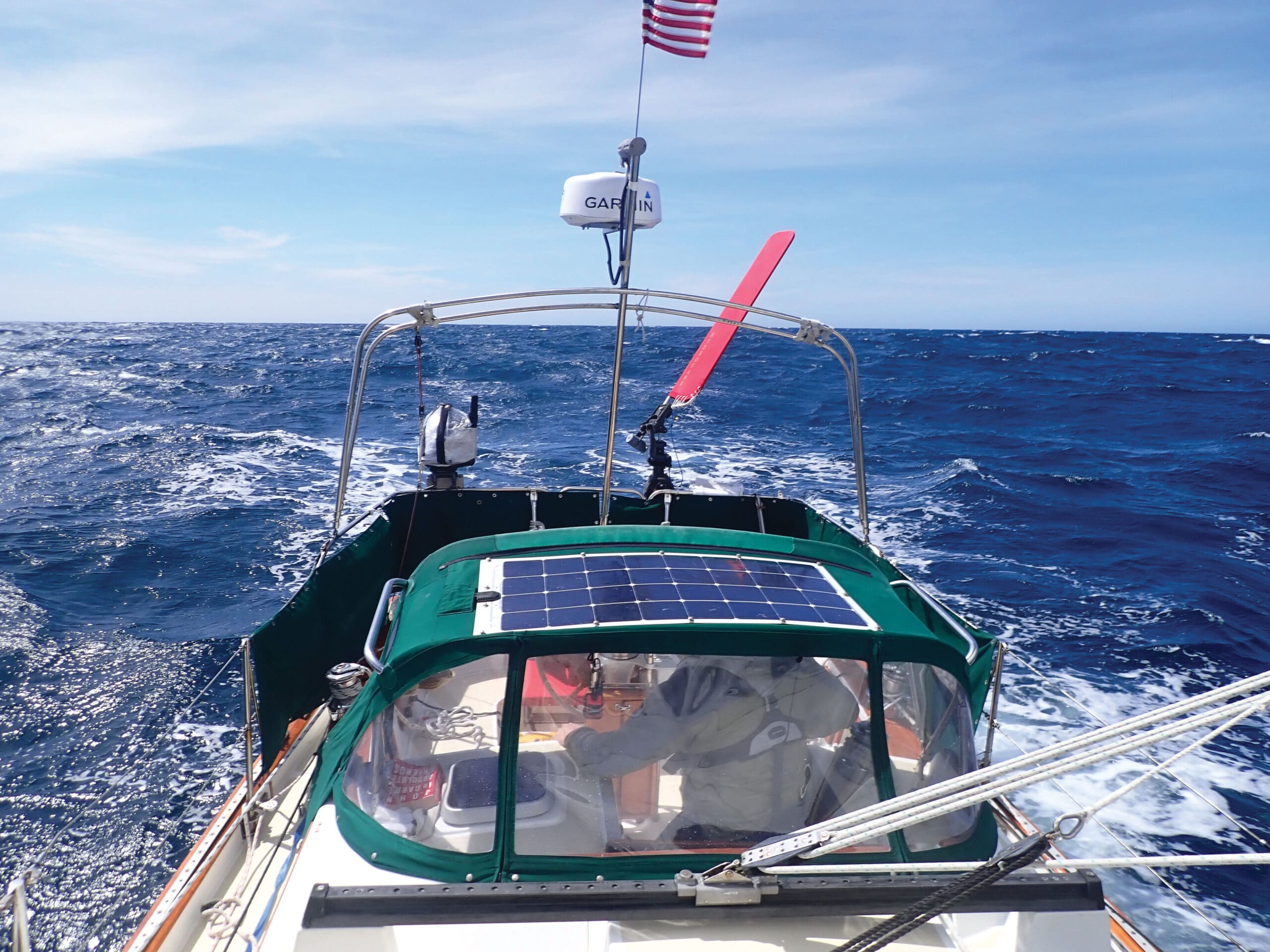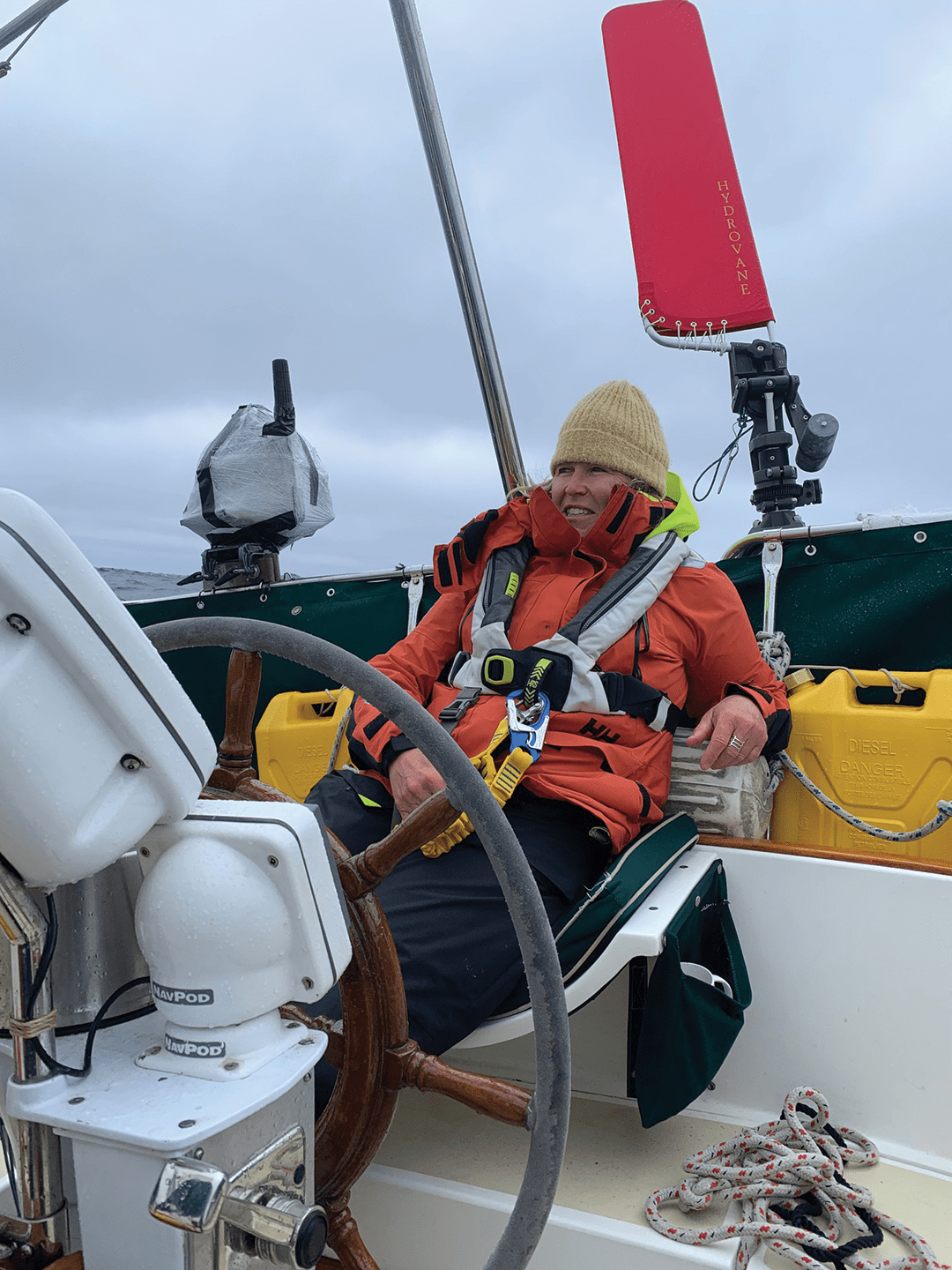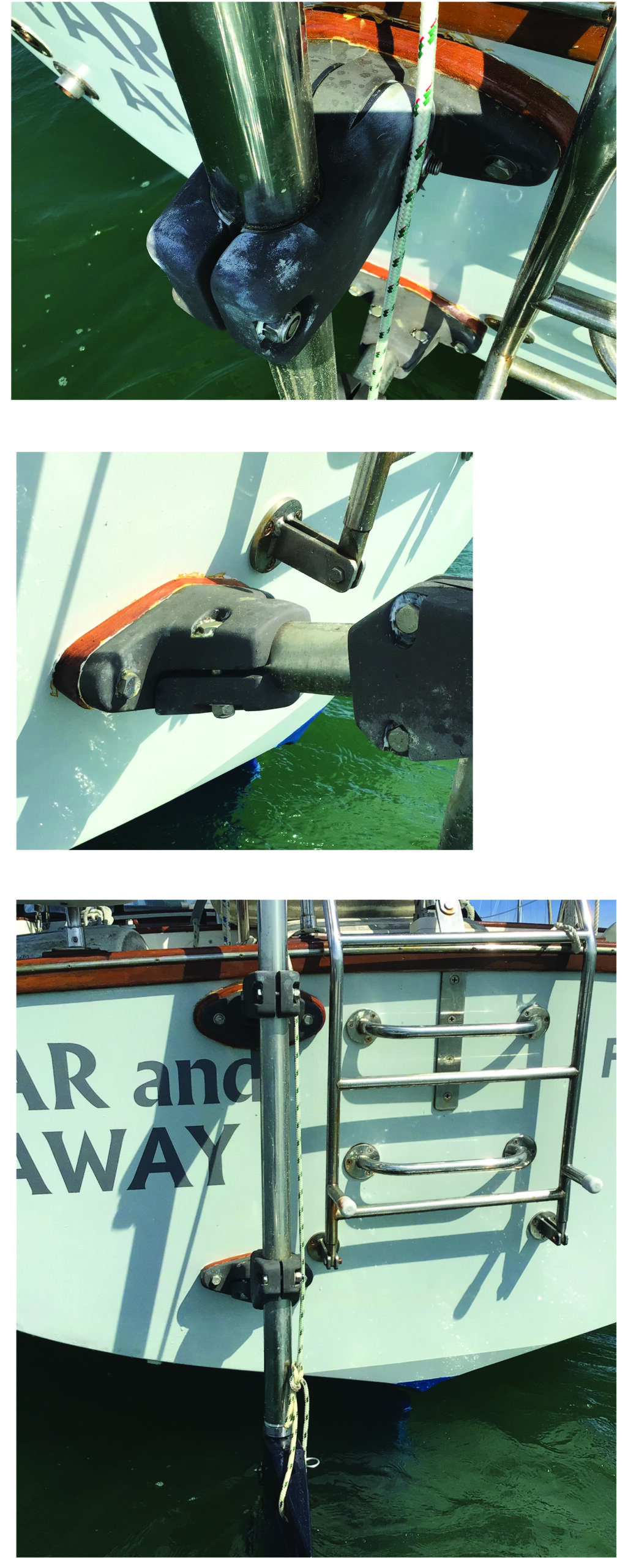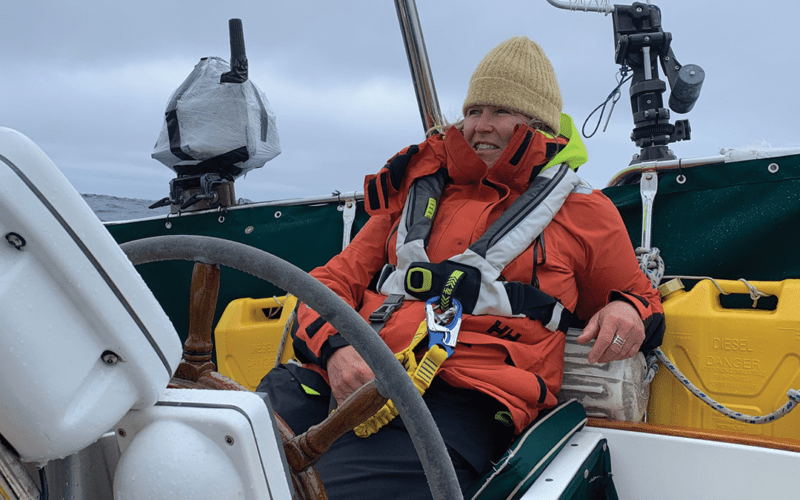
No less an authority than Don Street claims the first vane steering appeared in the 1930s on model sailboats such as ply the ponds of Central Park. In his 1973 classic, The Ocean Sailing Yacht, Street writes that not until 1955 was vane steering fitted on yachts in the servo-pendulum form invented by Colonel H.D. “Blondie” Hasler, who, Street writes, “should probably be regarded as the father of the vane self-steering gear.”
There are two fundamental types of vane self-steering, servo-pendulum and auxiliary rudder. In servo-pendulum steering, a windvane links to a paddle immersed in the water. When the yacht veers off course, the windvane deflects and causes the paddle to swerve to one side. The substantial pressure of the water acting on the paddle is transmitted via linkages to lines attached to the wheel or tiller, thus using the ship’s rudder to correct the course. Examples of servo-pendulum self-steering include the Aries, Monitor, several of the Windpilot models and the Cape Horn; there are others as well.
Auxiliary rudder systems use a windvane to turn a separate rudder perhaps a quarter the size of the main rudder. The auxiliary rudder itself steers the yacht, with the wheel or tiller tied off. Hydrovane is the best-known brand of this type, but the Windpilot Pacific Plus also uses an auxiliary rudder.
Proponents of servo-pendulum gears assert that an auxiliary rudder may be inadequate to keep the boat on course in high winds—that there is no better way to steer a yacht in a gale than with its own rudder. They also claim an auxiliary rudder is prone to damage (to the vane gear or even the transom) if it snags a line, and the auxiliary rudder impedes maneuvering in tight quarters.
Auxiliary rudder fans assert that the separate rudder provides an invaluable back-up steering system because the main steering is locked off, so the considerable wear an ocean passage imposes on steering gear is eliminated, and the system avoids inconvenient lines crossing the cockpit to the wheel.
A visit to the websites and forums shows that each of these points can be argued and counter-argued. Each established vane steering brand has fervent loyalists, each fan avowing that the (fill in the blank) steering system is the best gear I ever bought, it steered us through a ferocious storm,” etc. Brand loyalty aside, plainly, vane steering technology is now highly evolved, to the benefit of the modern blue water sailor.

Many sailors considering vane steering may be persuaded by the prevalence of Hydrovanes in the 2022 Golden Globe race, nonstop around the world via the Southern Ocean. Twelve of the 16 entrants chose Hydrovane, while two fitted Aries servo-pendulum gears and two the Windpilot, also a servo-pendulum.
In general, vane steering gear functioned well in this brutal test. Simon Curwen dropped out of the Golden Globe when the top mounting of his Hydrovane sheared off in a vicious knockdown. (Hydrovane told me this component had previously failed only in collisions, but in an abundance of caution, “We have since beefed up that casting.”) A bushing on Pat Lawless’s Aries gear failed and could not be repaired at sea.
The shaft of Damien Guillou’s Hydrovane fractured just above the rudder, a failure the race committee determined, after investigation, was caused by Damien’s having modified the shaft with two additional 7 mm holes (see the report at https://goldengloberace.com/golden-globe-race-windvane-safety-and-ggr-2026-open-for-entries). Ian Herbert-Jones’ drogue warp snagged the Hydrovane Rudder, and the resulting damage eventually caused the rudder to break in half. He anchored, found no other noticeable damage to the Hydrovane, put on his spare rudder and continued—only to lose his boat in a South Atlantic storm.
Race winner Kirsten Neuschäfer told me she chose Hydrovane for her 36-foot Cape George Cutter because of its reputation, but also because the Hydrovane is mechanically simpler than a servo-pendulum gear, with fewer parts to monitor or fail. She was happy with the choice. “The combination of the long keel and Hydrovane really worked great,” Kirsten said. The gear steered the yacht well in massive seas and winds gusting over 60 knots. At one point, “We took a really huge wave over the stern,” and the Hydrovane rudder was shoved hard to the side. The shaft clamps slipped, temporarily putting the Hydrovane rudder out of alignment with the control head but also, Kirsten believes, saving the gear because the system gave rather than broke.
Kirsten used the Hydrovane successfully while heaving-to, setting the vane so that it tried to steer her yacht into the wind. With the wheel locked off and the yacht abeam to the gale, the vane itself lay right over, which she believed tended to protect the Hydrovane rudder as the yacht surged, the effect of which was to steady the yacht and to keep her on the desired heading relative to wind and seas.
For Kirsten, one Hydrovane feature stood out. With a servo-pendulum gear, the rudder is tied into the vane system via lines to the wheel, so it is not possible to shift quickly from vane steering to hand steering and back again. Because the Hydrovane is entirely independent of the yacht’s wheel and rudder, one may, in heavy weather, stay at the wheel and allow the Hydrovane to steer, but when necessary override the Hydrovane by turning the wheel. In bad weather, Kirsten found this technique invaluable.
I had the same experience. Toward the end of my 2023 double-handed transatlantic on Far and Away, our Cabo Rico 34, we encountered a gale. Running in 40 knots and big seas, the Hydrovane seemed capable of safely steering Far and Away and did so hour after hour. However, given the conditions, one of us generally stayed at the wheel, and when an especially awkward sea reared up astern, we used the wheel to ease the yacht’s way. In those instances, we left the wheel brake on, steered the yacht over the brake, and when the dicey moment had passed, put the wheel back in the sweet spot and sat back. The yacht’s rudder will without difficulty overpower the Hydrovane rudder, so there was no need to de-clutch the Hydrovane. It was easy to do, the result was easier on the yacht and her crew, and, as Kirsten found, even if one must stay at the wheel, it is so much less taxing in heavy weather to steer now and again for a few moments than it is to steer continuously for a long watch.
When we bought Far and Away, she was equipped with a Raymarine autopilot fitted with a powerful linear drive mounted to its own rudder quadrant. It’s a proper setup and serves us well, but we cherish the autopilot for its ability to ease dull hours of motoring, and I had no intention of wearing it out on an ocean voyage. We wanted vane steering. I did my research and settled on the Hydrovane. It was proven, fairly simple, did not clutter the cockpit with steering lines and gave us a spare rudder to boot.

Installation was easy enough, although detailed planning was required to make sure there was no interference with either the centerline swim ladder or with components inside the transom. We went with the single-strut E bracket for the lower support and a hinged H bracket for the upper support, which means the system is secured to the hull by just four 10mm bolts, two to each bracket. Such an installation must be perfect, and we made several mockups to get there. Hydrovane is adamant that the bolts and their backing plates intersect at right angles, which on our boat required placing the backing plates (we used 5/16-inch aluminum) on a thick pad of epoxy, and likewise beveling and shaping the pads through which the foundation castings bolt to the transom.
Based on my experience, the Hydrovane is perfectly suited to a moderately sized, full-keel boat with the rudder mounted far aft, which, like Kirsten Neuschäfer’s Minnehaha, is Far and Away’s configuration. It is also proven to work well in other well-balanced designs, including in boats larger than ours and in those with fin keels and separate rudders. But with some yacht designs, even in some full-keel designs or in larger yachts, the Hydrovane may not do as well. Considering the high percentage of yachts using Hydrovanes in the 2022 Golden Globe race, it is worth bearing in mind that no entrant was over 36 feet long overall.
A friend of mine has a 38-foot, 19,000-pound Aage Nielson design, a beautiful, full-keel yacht with a cut-away forefoot and the rudder mounted on the trailing edge of the keel, but fairly far forward. He reports his Hydrovane worked well on any sort of reach, but while running, the yacht would at unpredictable intervals veer deeply, despite the Hydrovane rudder being at full deflection, straining so mightily to correct the course that the owner worried about mechanical failure. Eventually, this highly experienced sailor removed the Hydrovane from the boat.
One Valiant 42 owner wrote to me that he loved the Hydrovane, but even Hydrovane’s optional stubby vane bumped his solar arch. More critically, he believed the auxiliary rudder was inadequate for the Valiant 42’s big hull, and “the Hydrovane seems [to allow the boat] to wander significantly when in use.” He shifted to the Monitor servo-pendulum type and that has been satisfactory.
Another sailor has owned three yachts, two with servo-pendulum systems and the third, his Golden Wave 42, with a Hydrovane. This owner wrote to me, “All great, but as wind came abaft the beam, wandered. None good downwind.”
Because the Hydrovane rudder is a fraction of the size of a yacht’s rudder, the greater forces imposed by a larger, faster yacht may not allow the auxiliary rudder to steer a good course. Hydrovane says as much on its website: “In each case for heavy boats, the customer must help gauge the suitability. The Hydrovane’s steering power diminishes as the size of the boat increases and is challenged at higher boat speeds starting at perhaps 10 to 12 knots.”
Several years ago, I was crew on a 60-foot staysail schooner when, running in 40 knots of wind with 10 knots of boat speed and a building sea, the plainly overpowered Hydrovane allowed us to broach. There are those who believe the Aries, Monitor or another servo-pendulum type using the yacht’s rudder to steer is better suited to a big, heavy yacht, especially in gale conditions.
But while the “best” model of vane steering is debated and is, in my opinion, a matter of the yacht type, among serious cruisers, the value of vane steering is without dispute. On Far and Away, we’ve had vane steering for three years, and it has transformed our cruising. Double-handed passages, even ocean crossings, are not only do-able but a pleasure.
The vane has made me a better sailor by forcing me to take care to keep the yacht in balance and by telling me emphatically when I have failed. If you are on the fence about vane steering, do your research, talk to owners of similar boats about their experiences with various vane models and take the plunge. The brand name systems, whether Aries, Monitor, Windpilot, Hydrovane or another, are all proven good, and all have their zealous fans, but before you install your system, you must, as best as you can, ensure that it is a good match for your yacht.
Then you can go anywhere.
Nico Walsh is an admiralty attorney living in Freeport, Maine. A former Coast Guard officer, merchant mariner and commercial fisherman, Nico has been sailing for five decades. He and his wife Ellen cruise extensively on Far and Away, their Cabo Rico 34.

